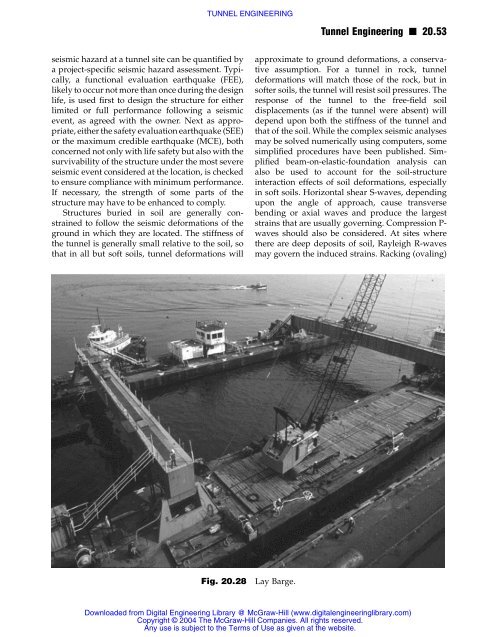TUNNEL ENGINEERING
TUNNEL ENGINEERING
TUNNEL ENGINEERING
You also want an ePaper? Increase the reach of your titles
YUMPU automatically turns print PDFs into web optimized ePapers that Google loves.
seismic hazard at a tunnel site can be quantified by<br />
a project-specific seismic hazard assessment. Typically,<br />
a functional evaluation earthquake (FEE),<br />
likely to occur not more than once during the design<br />
life, is used first to design the structure for either<br />
limited or full performance following a seismic<br />
event, as agreed with the owner. Next as appropriate,<br />
either the safety evaluation earthquake (SEE)<br />
or the maximum credible earthquake (MCE), both<br />
concerned not only with life safety but also with the<br />
survivability of the structure under the most severe<br />
seismic event considered at the location, is checked<br />
to ensure compliance with minimum performance.<br />
If necessary, the strength of some parts of the<br />
structure may have to be enhanced to comply.<br />
Structures buried in soil are generally constrained<br />
to follow the seismic deformations of the<br />
ground in which they are located. The stiffness of<br />
the tunnel is generally small relative to the soil, so<br />
that in all but soft soils, tunnel deformations will<br />
<strong>TUNNEL</strong> <strong>ENGINEERING</strong><br />
Fig. 20.28 Lay Barge.<br />
Tunnel Engineering n 20.53<br />
approximate to ground deformations, a conservative<br />
assumption. For a tunnel in rock, tunnel<br />
deformations will match those of the rock, but in<br />
softer soils, the tunnel will resist soil pressures. The<br />
response of the tunnel to the free-field soil<br />
displacements (as if the tunnel were absent) will<br />
depend upon both the stiffness of the tunnel and<br />
that of the soil. While the complex seismic analyses<br />
may be solved numerically using computers, some<br />
simplified procedures have been published. Simplified<br />
beam-on-elastic-foundation analysis can<br />
also be used to account for the soil-structure<br />
interaction effects of soil deformations, especially<br />
in soft soils. Horizontal shear S-waves, depending<br />
upon the angle of approach, cause transverse<br />
bending or axial waves and produce the largest<br />
strains that are usually governing. Compression Pwaves<br />
should also be considered. At sites where<br />
there are deep deposits of soil, Rayleigh R-waves<br />
may govern the induced strains. Racking (ovaling)<br />
Downloaded from Digital Engineering Library @ McGraw-Hill (www.digitalengineeringlibrary.com)<br />
Copyright © 2004 The McGraw-Hill Companies. All rights reserved.<br />
Any use is subject to the Terms of Use as given at the website.
















